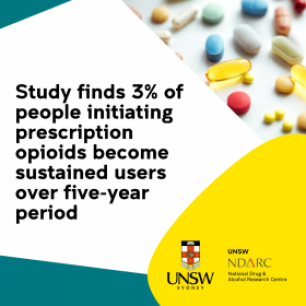A new study led by researchers at the National Drug and Alcohol Research Centre (NDARC), UNSW Sydney, has explored patterns of prescription opioid use over five years among people initiating opioids for the first time.
The study, published in the journal JAMA Network Open, used trajectory modelling to examine patterns of prescription opioid use over a five-year period following a new dispensing among the POPPY II study cohort. The POPPY II study is a retrospective cohort of approximately 3.5 million NSW residents who initiated a prescription opioid through the Pharmaceutical Benefits Scheme between 2003 and 2018.
Lead author Scientia Associate Professor Natasa Gisev found that approximately 3% of individuals were classified as having ‘sustained opioid use’ following initiation. This group were older, had more physical and mental health conditions, including cancer, and used more health services and other medicines.
In addition, 3% were identified as having ‘low increasing to moderate use’, 3% had ‘moderate decreasing to low use’ and 92% had low, time-limited opioid use.
Over the last thirty years, there have been concerns about the safety and appropriateness of opioid prescribing. Some key concerns include the potential for short-term use to become long-term use, and the development of opioid dependence. This study demonstrates that most people commencing a prescription opioid will have low and time-limited exposure to opioids over five-years. The small proportion of people with sustained use appear to have greater and more complex health needs.
“Understanding these long-term use patterns is an important first step to determining potential rates of harms among each of the groups identified,” said Scientia Associate Professor Natasa Gisev.
“Information on the characteristics of individuals with different opioid use patterns may be used to prevent future harms through targeted monitoring and interventions.” said Scientia Associate Professor Gisev.
Scientia Associate Professor Gisev said the findings also highlight the ongoing need to balance the benefits and harms of prescription opioid medicine use with clinical need.
“In light of ongoing policy and regulatory responses to improve the safety and appropriateness of opioid prescribing, it remains important to consider the different treatment needs of individuals and ensure that any negative impacts on those who require opioids are minimised,” said Scientia Associate Professor Gisev.
A link to the study in the journal JAMA Network Open can be found here.
You can find a detailed description of the POPPY study cohort here.
Media contacts:
Email: ndarc.media@unsw.edu.au | Natasa Gisev (Lead author): n.gisev@unsw.edu.au
For reference: When reporting on drug and alcohol issues, we encourage the consultation of the Mindframe guidelines on ‘Communicating about alcohol and other drugs’.
People can access free and confidential advice about alcohol and other drugs by calling the National Alcohol and Other Drug Hotline - 1800 250 015.


